This post is being continuously updated to add details about Android 12…
Update as of February 11: If you are aware of the Material You theming system for Pixel devices from Google, turns out Google is rolling it out across different OEMs as well. I am talking about Tecno, Realme, Vivo, Oppo, Xiaomi, Samsung, and OnePlus all donning the new dynamic theming system across its interface. Also, more OEMs are working on the design APIs to adopt such features on their devices as well.
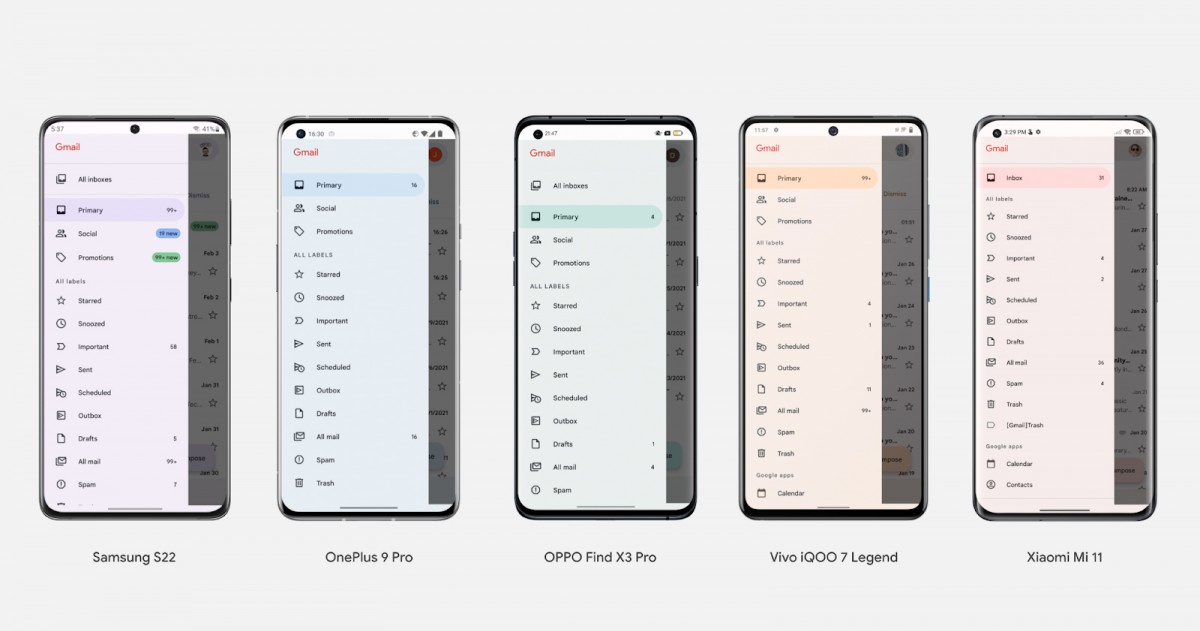
Update as of December 15: Turns out Google has released Android 12 Go Edition based on Android 12. It is a lightweight version for budget and entry-level smartphones promising faster app launches by up to 30 percent with smoother animation, longer battery life thanks to its hibernating apps feature. The Android 12 Go offers translation on-screen content in preferred language, Nearby Share, guest login, and robust privacy controls available at your disposal. Read more about it here.
Update as of October 28: Google has released a new iteration of Android 12 dubbed as Android 12L built for devices with dual screens and foldable displays. It was announced at the Developer Summit and marks the first interim update in years. The Android 12L will allow OEMs to introduce features for larger screen devices although it will be available for those with smaller displays as well. Features such as spatial audio, drag-and-drop are a few ones introduced with Android 12L.[Read more here]
Google has finally revealed their next version of Android called Android 12 to the public with beta update. At the Google I/O 2021 conference, they showcased the latest version with their new ‘Material You’ design which is highly customizable and brings a completely revamped UI. With this new version, Google has focused on privacy, design, widgets, and more.
With the Android 12 beta version, Google has partnered with Asus, OnePlus, Oppo, Realme, Tecno, Sharp, TCL, Xiaomi, Vivo, and ZTE to bring the beta build officially. Currently, the Android 12 beta update is available for Google’s Pixel phones, starting from the Pixel 3 series through the Pixel 5.
If you don’t have a Pixel phone, then you can try the same build on the latest smartphone from the partnered brand including OnePlus, Xiaomi, Realme, Oppo, Vivo, and Asus. Install the best android apps on your Phone once you get android 12 so you don’t miss out on new interesting apps.
Page Contents
What’s New In Android 12?
After the release of Android 12 beta 1, these are the confirmed features to get on the stable version according to Google.
Faster Autorotate
Google is progressively refining the autorotate feature on Android 12. With Beta 3, it now works with the front camera. It detects the face and orientation of the user before triggering to rotate when the auto-rotate feature is enabled. It will resolve infinite queries of users accidentally rotating their screens when they lie down or even turn the phone a bit where the accelerometer detects the motion and triggers autorotate. It now uses Private Compute Core to do all the images captured by the front camera to trigger autorotate on-device without any data leaving the device.
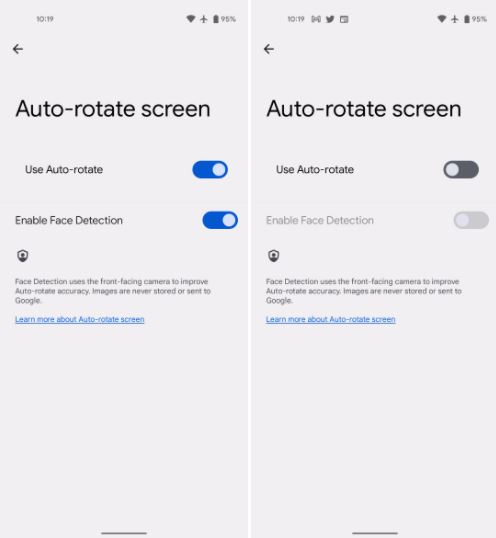
According to Google, the feature is available on Pixel 4 and above running Beta 3. It will further use the ML-aided gesture detection algorithm among others to bring down the latency by 25 percent.
Games API
Android 12 Beta 3 brings upgrades to Game Mode APIs that allows users to create performance profiles. Here, the Game Mode will prioritize better battery life or high performance with peak frame rates accordingly. The concerning API will be joined with the Game Dashboard that will be available for selected devices later this year.
As reported earlier, now Android 12 allows playing games when the game assets are being downloaded off the Google Play Store. This ensures that all the assets are downloaded and the user won’t have to wait for the download to finish before playing it for the first time.
Improved Scrolling Screenshots
Okay, it’s scrolling screenshots again. However, with Android 12 Beta 3, Google has improved it a step ahead. Now, scrolling screenshots will work on windows that are scrollable. Android 12 Beta 3 scrolling screenshots are based on views rather than taking a bunch of images and stitching them together. Google states that users can tap on “Capture more” which appears if the view is scrollable. Users are free to adjust the crop and more with this feature.
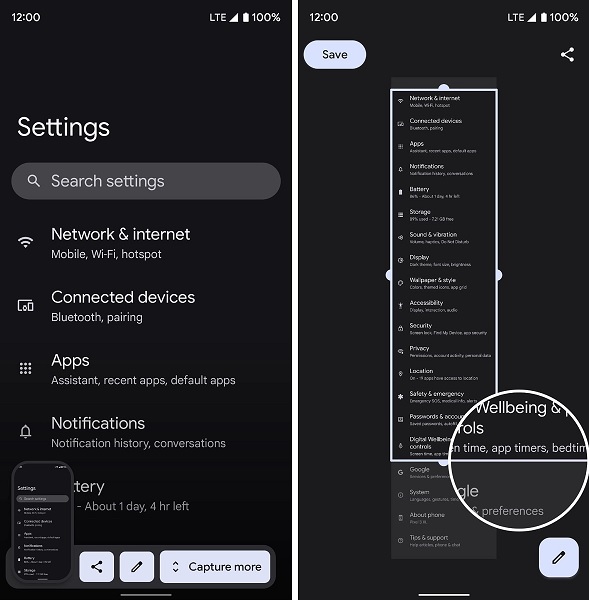
According to Google, scrolling screenshots on beta 3 will work out-of-the-box for all apps with standard View-based UI. It has rolled out the ScrollCapture API to instruct the app to take scrolling screenshots in case the app users customized UI or non-View-based UI.
On-device search
The Beta 3 brings On-device search onboard which uses the new AppSearch API. The AppSearch feature enables a high-performance on-device search engine where the API has two flavors i.e. a local index and a central index where the former deals with an app to use it with its backward compatibility while the latter deals with showcasing app data on System UI with permission.
Material YOU, Revamped UI: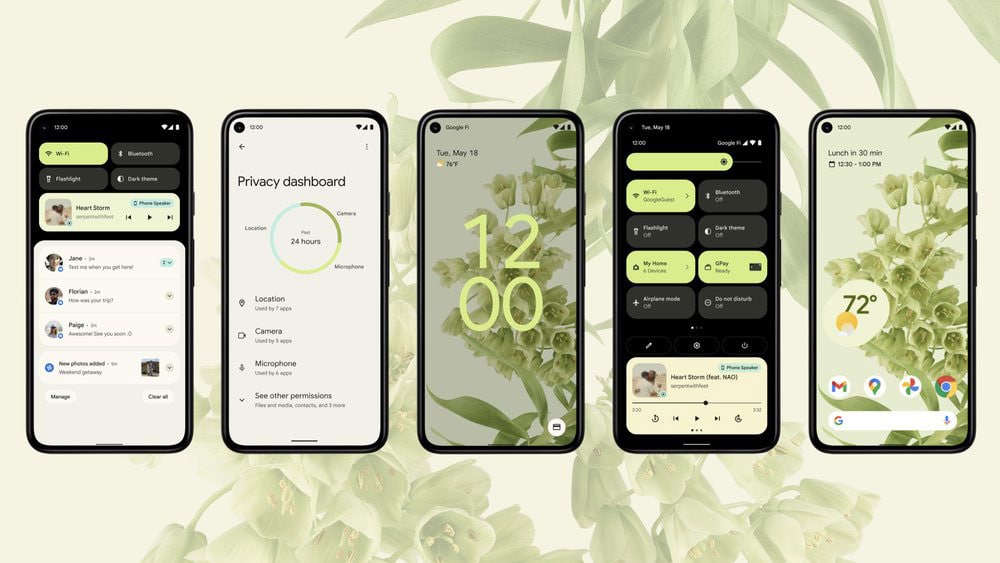
After many years, Google has finally decided to change the visual overhaul of the Android OS. With the Android 12 version, Google has introduced the Material You which brings the color extraction from your installed wallpaper. This will automatically choose the color from your Wallpaper to the whole system such as the Calling menu, Settings, Notifications, Music, Google Apps, and many more.
New Android 12 Quick Tiles
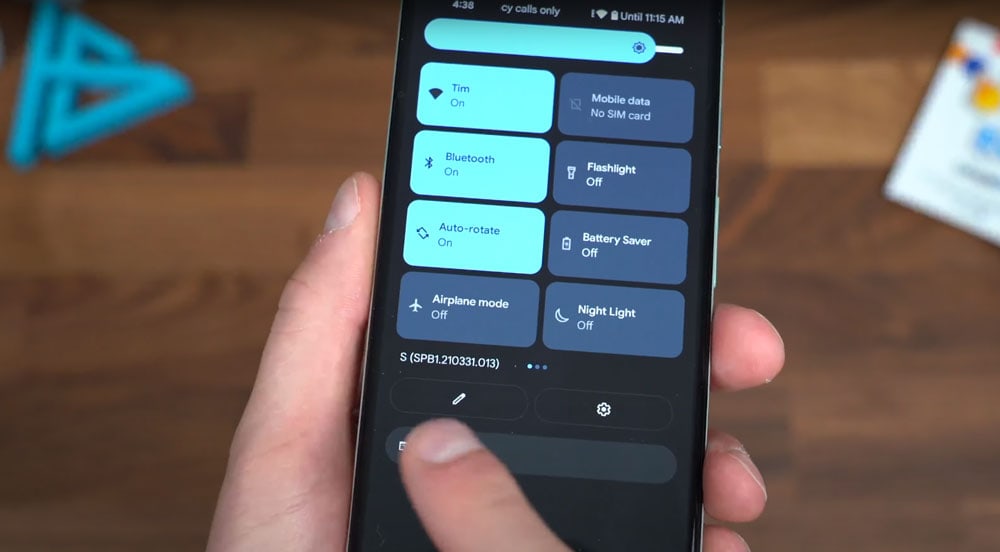
Just like every version, Google also redesigned the quick tiles in this Android 12 version too. Yes, Google has finally removed the round icons and redesigned them with large text tiles which look beautiful, elegant, and quickly accessible.
Fluid Motion and Animations

According to Google, this new version of Android 12 brings a completely new animation and smooth motion which brings a unique feeling to the device. This is achieved by some under-the-hood improvements including reducing the CPU time needed for core system services by up to 22% and reducing the use of big cores by the system server by up to 15%. For more
Notification improvements

With Android 12, Google has redesigned with notification layout to improve the usability, functionality, and animation.
The Quick Settings space doesn’t just look and feel different. It’s been rebuilt to include Google Pay and Home Controls, while still allowing for customization so you can have everything you need most in one easy-to-access place. To know more, click here
Privacy and security improvements

At Google I/O 2021, Google has announced their new privacy system for Android 12 which makes the Android system more secure and transparent. It gives you more transparency around which apps are accessing your data, and more controls so you can make informed choices about how much private information your apps can access.
One-Handed Mode:
When Google first rolled the preview build, we saw the Android system is shifting to the one-handed mode just like iOS. If you swipe down, you can activate the one-handed mode which makes it easy to access the device feature on a huge phone in size. By swiping it brings the top half of the display downwards which allows you to reach the buttons, icons, notification, and more.
How to Get Android 12 Beta Update?
For Pixel users starting from Pixel 3 to Pixel 5, you can simply download and flash the Android 12 beta flashable zip, or you can opt-in to get the Android 12 beta OTA on your device.
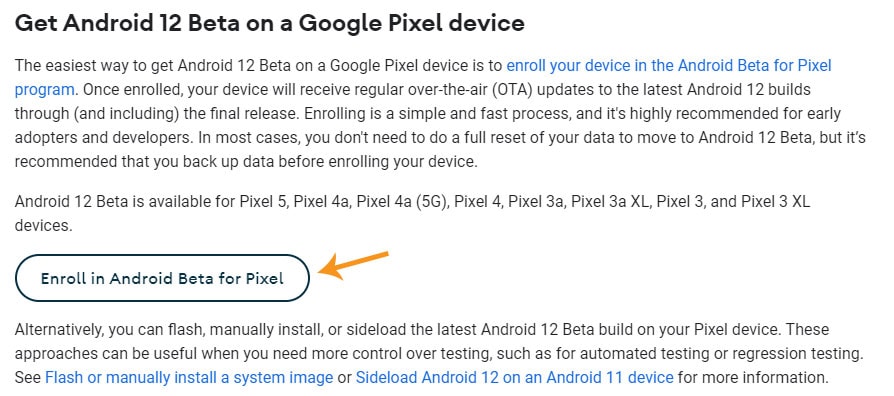
If you have any device which is partnered with Google for Android 12 beta such as Asus Zenfone 8, OnePlus 9 series, Oppo Find X3 Pro, Realme, Tecno Camon 17, Sharp, TCL, Xiaomi Mi 11 series, Vivo, and ZTE.
Android 12 Beta Supported Device:
Google Pixel:
- Google Pixel 3
- Google Pixel 3a
- Google Pixel 3 XL
- Google Pixel 4
- Google Pixel 4 XL
- Google Pixel 4a
- Google Pixel 4a 5G
- Google Pixel 5
- Google Pixel 5a 5G
- Google Pixel 6
- Google Pixel 6 Pro
Nokia:
- Nokia X20 (More Info)
OnePlus:
Xiaomi:
- Xiaomi Mi 11 – Download
- Xiaomi Mi 11 Ultra – Download
- Xiaomi Mi 11i – Download
- Xiaomi Mi 11X Pro – Download
- Xiaomi Redmi K40 – Android 12 Beta ROM China – Download
- Redmi K40 Pro+ – Android 12 Beta ROM China – Download
Asus:
- Asus ZenFone 8 – Download
TCL:
- TCL 20 Pro 5G – Download
Tecno:
- Tecno Camon 17 – Download
Oppo:
- Oppo Find X3 Pro – Download
Realme:
- Realme GT – Downoad (China Only)
Vivo:
- Vivo iQOO 7 Legend
ZTE
- ZTE Axon 30 5G Ultra – Download
Devices that will receive the Android 12 update
Most Android manufactures release at least two major Android updates for their smartphones. Thus, we can expect all devices that come with Android 10 pre-installed to receive the Android 12 update when it arrives. Of course, there can be a few exceptions or additions to the list. But we do expect the following devices to get Android 12 when it is available.
Huawei | Honor
- Huawei P40 | P40 Pro | P40 Pro+ | P40 Lite
- Huawei P Smart S
- Huawei Nova 7i
- Honor Magic3
- Honor Magic3 Pro
- Honor Magic3 Pro+
LG
Update as of April 12: Despite the fact that LG is already exiting the smartphone market, it has maintained that it will continue to push out Android updates for both major OS and security patches. Turns out LG has published listings of devices that are eligible for Android 12. With that being said, here’s the list of devices eligible for Android 12. Also, check out for the asterisk (*) sign for units that are eligible for Android 13 as well.
- LG Wing*
- LG Velvet 5G*
- LG Velvet LTE*
- LG V50S
- LG G8
- LG Q31
- LG Q52
- LG Q92 5G
Infinix
Update as of September 20: Note that this is an unofficial list and thus, it is subject to change.
- Infinix Hot 11 / 11S
- Infinix Zero X / X Pro / X Neo
- Infinix Hot 10i / 10S / 10S NFC
- Infinix Hot 10T
- Infinix Note 10 / 10 Pro
- Infinix Hot 10 Lite*
- Infinix Smart HD 2021*
- Infinix Smart 4 / 4 Plus*
- Infinix Smart 5*
- Infinix Note 7 / 7 Lite*
- Infinix Note 8i*
- Infinix S5 Pro*
- Infinix Hot 10 / 10 Play*
- Infinix Hot 9 / 9 Pro*
- Infinix Zero 8 / 8i*
Note: Devices that are marked with asterisk “*” may or may not get the Android 12 upgrade.
Motorola
- Motorola Moto G Stylus (2022)
- Motorola Edge X30
- Motorola Moto G200 5G
- Motorola Moto G71 5G
- Motorola Edge S30
- Motorola G Power (2022)
- Motorola Edge 20 | 20 Pro | 20 Lite | 20 Fusion
- Motorola Moto G60S
- Motorola Moto G60
- Motorola G40 Fusion
- Motorola Moto G100
- Motorola Moto G51 5G
- Motorola Moto G50
- Motorola Moto G41
- Motorola Moto G31
- Motorola Moto G20
- Motorola Moto G30
- Motorola Moto G10 | G10 Power
- Motorola Moto G9 Plus | G9 Play
- Motorola Edge | Motorola Edge+ | Motorola Edge S
- Motorola Razr 5G
- Motorola G 5G | G 5G Plus
- Motorola Moto G Power 2021
- Motorola Moto G Stylus 2021
- Motorola Moto One 5G | One 5G Ace
- Motorola One Fusion | One Fusion+
- Motorola One Hyper
- Motorola Moto G8 | Moto G8 Power*
- Motorola Moto G Power | G Fast
- Motorola Moto E7 | E7 Plus | E7 Power*
Note: This isn’t an official Android 12 supported Motorola smartphones list. There is a high probability that some of these devices may not get Android 12 and especially those marked with the asterisk “*” sign.
Nokia
Update as of March 30: Nokia has one of the most impressive lineup of devices thanks to their capability to get Android upgrades faster than many other smartphones. The Android 12 on Nokia devices is not yet confirmed since the latter hasn’t confirmed a list of devices nor the schedule that it will follow in its rollout. Google has already released Android 12 Developer Preview v2.1 and will soon release DP3 in a few days time which means the beta updates will commence soon which is when non-Google devices get their hands on the update.
With that being said, here’s a tentative list of Nokia smartphones that will get their hands on Android 12 although take it with a pinch of salt since the Finnish tech giant which is now operating under HMD Global hasn’t confirmed the list yet.
- Nokia 1.3
- Nokia 2.4
- Nokia 3.4
- Nokia 5.3
- Nokia 5.4
- Nokia 8.3 5G
- Nokia 8 V 5G UW
- Nokia X20
OnePlus
- OnePlus 10 Pro 5G
- OnePlus Nord CE 2 5G
- OnePlus Nord 2 5G
- OnePlus Nord N200 5G
- OnePlus 9
- OnePlus 9 Pro
- OnePlus 9R
- OnePlus 8T
- OnePlus Nord
- OnePlus 8 | OnePlus 8 Pro
- OnePlus 7T | OnePlus 7T Pro
- OnePlus 7 | OnePlus 7 Pro
- OnePlus 6* | OnePlus 6T
Note that both OnePlus Nord N100 and Nord N10 5G arrived with Android 10-based OxygenOS 10 out-of-the-box. This renders them unable to receive Android 12 update but take it with a pinch of salt.
Note that last year, OnePlus rolled out Android 11 DP on OnePlus 8/8 Pro in June. This year, the OnePlus 9 series will be official in the coming weeks and thus, it will also get Android 12 DP version soon although we won’t put any timeline just yet.
Oppo
Update as of September 16: Oppo has officially launched the ColorOS 12 based on Android 12. This is the list of devices that will get the Android 12 update although it also contains some models which may or may not pick it up.
- Oppo Find N
- Oppo Find X3/ X3 Pro/ X3 Neo/ X3 Lite
- Oppo Find X2/ X2 Neo/ X2 Lite/ X2 Pro
- Oppo F19/ F19 Pro/ F19 Pro+ 5G
- Oppo Reno5 4G/ 5G/ Pro/ Pro+ 5G/ Lite/ F
- Oppo Reno3/ 5G/ Pro 4G/ Pro 5G/ Youth
- Oppo Reno4 5G/ 4 Lite/ 4 Pro/ 4 F/ 4 Z 5G
- Oppo A9 (2020)
- Oppo A92s
- Oppo A94
- Oppo A72
- Oppo A15/ A15s
- Oppo A53
- Oppo A93
- Oppo F17/ F17 Pro
- Oppo A72 5G
- Oppo A55 5G
- Oppo K7 5G/ K7x
- Oppo Reno R
Realme
Update as of November 12: According to the latest update, GT Master Discovery Edition is now picking up Android 12-powered Realme UI 3.0 in China where about 700 people will get their hands on the update. Registration started on November 11 at 11:30 hrs and will be open till registration. [Read more here]
Update as of October 16: Realme has released the Realme UI 3.0 Early Access Roadmap that it will follow for the enlisted devices to get their hands on Realme UI 3.0.
Update as of October 13: It’s here. The Realme UI 3.0 based on Android 12 has been unveiled and with that, users will get their hands on the early access builds this month i.e. October. There are no dates available at the time of writing this. Check it out here.
Update as of October 5: Tipster Digital Chat Station has got his hands on a few screenshots of the new Realme UI 3.0 and turns out it looks more than ColorOS 12 based on Android 12.
Update as of September 23: According to Realme VP Xu Qi, Realme UI 3.0 is based on Android 12 and it is expected to arrive in October. There’s no specific date available at the moment.
Update as of February 24: After OnePlus and Samsung, we have come up with the tentative list of Realme devices that will get their hands on Realme UI 3.0 based on Android 12 once it arrives later this year.
- Realme Pad
- Realme X7 Max 5G0
- Realme 8 | 8 5G | 8 Pro | 8i | 8s 5G
- Realme Narzo 30 | Narzo 30 5G
- Realme GT Neo Flash
- Realme Q3 Pro Carnival
- Realme X50 | X50 Pro 5G
- Realme X50 Player Edition
- Realme X50
- Realme X7
- Realme X7 Pro
- Realme X3 SuperZoom
- Realme 7i
- Realme 7 Pro
- Realme 7
- Realme X3
- Realme Narzo 10
- Realme 6i
- Realme 6 | 6 Pro
- Realme C3
- Realme Narzo 20
- Realme Narzo 20A
- Realme Narzo 20 Pro
- Realme Narzo 30A
- Realme Narzo 30 Pro 5G
- Realme C25
- Realme C12
- Realme C15
- Realme C17
- Realme V11 5G
- Realme V15 5G
- Realme Q2 Pro
- Realme GT 5G | GT Neo | GT Master Discovery Edition
Samsung
Update as of September 14: Samsung has finally released Android 11-powered OneUI 4.0 Beta update to the entire Samsung Galaxy S21 series weighing at 2422.17MB and has a September 2021 security patch with it. The version number is ZUID/ZUID/BUI8.
Update as of May 25th: Here’s the list of Samsung devices that will get Android 12-powered OneUI 4.0 although it could change if not stay completely true.
- Samsung Galaxy S22 5G | S22+ 5G | S22 Ultra 5G
- Samsung Galaxy Tab S8 | Tab S8+ | Tab S8 Ultra
- Samsung Galaxy Z Fold3 5G
- Samsung Galaxy Z Flip3 5G
- Samsung Galaxy S21 | Galaxy S21+ | Galaxy S21 Ultra (LTE / 5G)
- Samsung Galaxy S20 | Galaxy S20+ | Galaxy S20 Ultra (LTE / 5G)
- Samsung Galaxy S20 FE (LTE / 5G)
- Samsung Galaxy S10 | Galaxy S10+ | Galaxy S10e | Galaxy S10 Lite
- Samsung Galaxy Note 20 | Note 20 Ultra
- Samsung Galaxy Note 10 | Note 10+ | Note 10 Lite
- Samsung Galaxy Z Fold2
- Samsung Galaxy Z Flip (LTE / 5G)
- Samsung Galaxy Fold
- Samsung A90 5G
- Samsung Galaxy A71 / A71 5G
- Samsung Galaxy A51 / A51 5G
- Samsung Galaxy A52 / A52 5G
- Samsung Galaxy A52s 5G
- Samsung Galaxy A72
- Samsung Galaxy A31
- Samsung Galaxy A41
- Samsung Galaxy A11
- Samsung Galaxy A21
- Samsung Galaxy A21s
- Samsung Galaxy A32 / A32 5G
- Samsung Galaxy A02s
- Samsung Galaxy A02
- Samsung Galaxy A12
- Samsung Galaxy A01
- Samsung Galaxy A Quantum
- Samsung Galaxy Quantum 2
- Samsung Galaxy M01
- Samsung Galaxy M02
- Samsung Galaxy M02s
- Samsung Galaxy M12
- Samsung Galaxy M21
- Samsung Galaxy M21s
- Samsung Galaxy M31
- Samsung Galaxy M31 Prime Edition
- Samsung Galaxy M31s
- Samsung Galaxy M42 5G
- Samsung Galaxy M51
- Samsung Galaxy M62
- Samsung Galaxy M51
- Samsung Galaxy Tab S6 | Tab S6 5G | Tab S6 Lite
- Samsung Galaxy Tab S7 | Tab S7+ (LTE / 5G)
- Samsung Galaxy Tab A 8.4
- Samsung Galaxy Tab Active 3
- Samsung Galaxy Tab A7
- Samsung Galaxy F41
- Samsung Galaxy F62
- Samsung Galaxy F02s
- Samsung Galaxy F12
- Samsung Galaxy Xcover Pro
- Samsung Galaxy Xcover 5
[Source]
When it comes to Android 12 release, it is expected to arrive in August/September 2021 as a stable version. Once the first public arrives, Samsung could start rolling out beta builds on its top lineup followed by others. It is expected that Samsung could release Android 12 stable update on the 2021 flagship devices (S21 series and Note21 series) by December if not earlier.
Xiaomi
Update as of September 11: Looks like Xiaomi has added a new smartphone in the internal Android 12 testing phase. I am talking about Poco F3 GT (mojito) and Redmi K40 Gaming (ares) that are now part of Android 12 testing phase.
Update as of September 7: Xiaomi has added some new smartphones in the Android 12 internal testing program. This includes Redmi 10, Redmi Note 10 Pro, Redmi Note 10 Pro max, Xiaomi 11T Pro, Mi 11 Lite 4G, and Mi 11 Lite NE.
Update as of July 5: As per the list of Xiaomi devices to get Android 12 posted by a popular Telegram channel, here’s the list.
- Xiaomi 11T / 11T Pro
- Xiaomi Mi 11 Lite 5G NE
- Xiaomi Mi Mix 4
- Xiaomi Mi Pad 5
- Xiaomi Mi Pad 5 Pro
- Xiaomi Mi 11 / Pro / Ultra*
- Xiaomi Mi 11i / Mi 11X / Mi 11 Pro / Mi 11 Lite 5G*
- Xiaomi Mi 10S*
- Poco F3 / Redmi K40 / Redmi K40 Pro / Redmi K40 Pro+*
- Xiaomi Mi 10/ 10 Pro/ Ultra
- Xiaomi Mi 10 Lite 5G/ Zoom / Youth
- Xiaomi Mi 10i / Mi 10T Lite
- Xiaomi Mi 10T / 10T Pro
- Mi MIX Fold
- Xiaomi Redmi 10
- Xiaomi Redmi 10X 5G / 10X Pro
- Xiaomi Redmi Note 9 / Redmi Note 9 Pro / Redmi Note 9 Pro Max / Redmi Note 9S
- Xiaomi Note 9 5G / Note 9T / Note 9 Pro 5G
- Redmi Note 10 / 10S / 10T / 10 5G
- Redmi Note 10 Pro / Pro Max
- Redmi Note 10 Pro 5G (China)
- Redmi Note 8 2021
- Redmi K30 / K30 5G / K30 5G Racing / K30i 5G / K30 Pro/ K30 Zoom / Redmi K30 Ultra / K30S Ultra
- Redmi K40 Gaming
- Poco F2 Pro
- Poco F3 GT
- Poco X3 GT
- Poco X2 / X3 / X3 NFC / X3 Pro
- Poco M3 / M3 Pro 5G
- Poco M2 / M2 Reloaded / M2 Pro
- Poco C3
- Blackshark 4 / Blackshark 4 Pro / Blackshark 3s
- Blackshark 3 | Blackshark 3 Pro
- Redmi 9T / 9 Power #
- Redmi Note 9 (Global) / Redmi 10X 4G #
- Redmi Note 9 4G (China) #
- Mi Note 10 Lite #
Note: Devices marked with asterisk (*) are already a part of Android 12 beta development; those marked with hashtag (#) are those that “may” get the update and finally, others are those that will get the update albeit unofficial.
Vivo
Update as of April 11: Vivo made quite a name for itself after rolling out Android 11 update to a handful of smartphones even before Android 11 was official. It has already rolled out across more devices so far and here’s a list of devices that are slated to get Android 12-powered FuntouchOS 12. Take it with a pinch of salt since Vivo hasn’t released the list officially.
- Vivo X70 | X70 Pro | X70 Pro+
- Vivo X60 | X60 Pro | X60 Pro+ | X60t
- Vivo X50 | X50 5G | X50 Pro | X50 Pro+ | X50e | X50 Lite
- Vivo X51 5G
- Vivo S9 | S9e
- Vivo X51 5G
- Vivo NEX 3S 5G
- Vivo S7 | S7e | S7t
- Vivo Y30 (China/ Standard)
- Vivo Y31| Y31s
- Vivo Y11
- Vivo Y20 | Y20s | Y20G | Y20 2021 | Y20i
- Vivo Y12s
- Vivo Y51 (Dec 2020) | Y51s | Y51a
- Vivo Y52s
- Vivo Y70 | Y70s
- Vivo Y73s
- Vivo V19
- Vivo V20 | V20 Pro | V20 SE
- Vivo iQOO 8 | 8 Pro
- Vivo iQOO Z1/ Z1x
- Vivo iQOO U1x | U2x | U3
- Vivo iQOO 7
- Vivo iQOO Neo5 | Neo3 5G
- Vivo iQOO 3 5G
- Vivo iQOO 5 5G | 5 Pro 5G
- Vivo iQOO Z3
Sony
- Sony Xperia 1 II
- Sony Xperia 1 III
- Sony Xperia 5 II
- Sony Xperia 5 III
- Sony Xperia 10 III
- Sony Xperia 10 II
- Sony Xperia Pro
- Sony Xperia 1*
- Sony Xperia 5*
Note that devices that are marked with the asterisk “*” sign may or may not get the Android 12 due to xyz reasons.
Asus
Update as of April 19: Now smartphone manufacturer has officially released an Android 12 supported device and Asus isn’t an exception. It has plenty of smartphones that are likely to get Android 12 although its update schedule takes a lot of heat for constant dealsy and whatnot. Well, we have a tentative list of Asus smartphones that are likely to make it to Android 12 although take it with a pinch of salt at the moment.
- Asus ROG Phone 5s
- Asus ROG Phone 5s Pro
- Asus ROG Phone 5
- Asus ROG Phone 5 Pro
- Asus ROG Phone 5 Ultimate
- Asus ZenFone 7
- Asus ZenFone 7 Pro
- Asus ROG Phone 3
- Asus ROG Phone 3 Strix
As we mentioned earlier, the Android 12 supported device list is only as per our speculation at the moment. No device on the list is guaranteed to receive the Android 12 update.

My mobile devices name vivo y 31 download link send me
My phone samsung s9 new update i need him